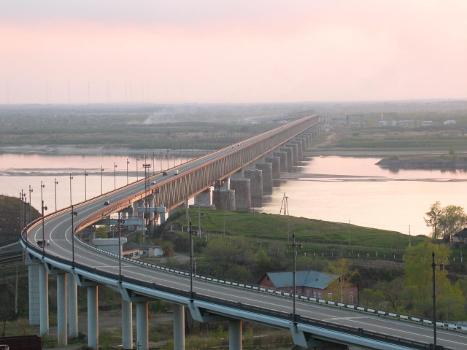General Information
Project Type
| Structure: |
Through truss bridge |
|---|---|
| Material: |
Steel bridge |
| Structure: |
Parallel-chord truss bridge |
| Support conditions: |
for registered users |
| Material: |
Structurae Plus/Pro - Subscribe Now! |
| Function / usage: |
upper deck: Road bridge lower deck: Railroad (railway) bridge |
Location
| Location: |
Khabarovsk, Khabarovsk Krai, Far Eastern Federal District, Russia Imeni Telmana, Jewish Autonomous Oblast, Far Eastern Federal District, Russia |
|---|---|
| Crosses: |
|
| Carries: |
|
| Part of: |
|
| Replaces: |
Tsar Alexey Bridge (1916)
|
| Coordinates: | 48° 32' 10" N 135° 0' 2" E |
Technical Information
Dimensions
| total length | 3 890.5 m | |
| main bridge | ||
|---|---|---|
| main span | 128.4 m | |
| total length | 2 599 m | |
Materials
| truss |
steel
|
|---|
Excerpt from Wikipedia
Khabarovsk Bridge is a road and rail bridge built in 1999. It crosses the Amur River in eastern Russia, and connects the urban-type settlement of Imeni Telmana in the Jewish Autonomous Oblast with the city of Khabarovsk in Khabarovsk Krai. Until that time an older bridge built in 1916 existed nearby.
History
Railway bridge built 1916
Khabarovsk Bridge was originally built in 1916 as a single-track structure that carried the Trans-Siberian Railway line across the Amur River near the city of Khabarovsk, Russia. The bridge remained the longest bridge in Imperial Russia and the Soviet Union for decades, having a length of 2,590 metres (8,500 ft).
The bridge construction was supposed to cost 13,500,000 Russian rubles, and to be done in only 26 months to a design by the eminent bridge builder Lavr Proskuryakov. However, a year after construction began on 30 July 1913, the First World War broke out. Since the bridge was being constructed by Warsaw-based K. Rudzki i S-ka company and the spans were manufactured in ist factory in Mińsk Mazowiecki, they had to be brought to Khabarovsk by sea all the way around Eurasia.
In fall 1914, a merchant ship carrying the last two spans was sunk in the Indian Ocean by the German cruiser Emden, delaying the completion of the bridge by more than a year. The bridge was finally completed for an official opening on October 5, 1916. It was named Alekseyevsky after Alexei Nikolaevich, Tsarevich of Russia.
On April 5, 1920, two of the bridge's eighteen metal spans were detonated by the guerrilla units retreating from Khabarovsk during the provocative speeches of the Japanese military over the course of the Civil War. As a result, the Trans-Siberian railway was torn apart for 5 years.
The reconstruction began shortly after the establishment of Soviet rule in the Far East (since November 1922). The 13th span was assembled in Vladivostok at the plant Dalzavod from the damaged parts of the spans that had fallen into the river by one end. Instead of the 12th span, a reserve one across the Vetluga River (a tributary of the Volga River) was installed, which had a slightly different shape, but was suitable by ist dimensions and design. Minor repairs and missing parts were made by the Khabarovsk plant Arsenal (now Daldiesel). The bridge was re-opened to through traffic by March 22, 1925.
In the 1980s, research was undertaken on the bridge with the objective of ist renovation. The spans and arches of the bridge were found to be defective, and so speed limits were imposed. At the same time, the bridge's pillars were in satisfactory condition.
Bridge built 1999
In 1999, a new bridge was built right next to the old one, carrying automobile and rail traffic on two levels. It is 3,890 m long. The original spans of the old bridge were dismantled in the 21st century, though ist supports were preserved. One of the spans of the old bridge was saved, restored and set on the banks of the Amur in the Museum of Khabarovsk Bridge, which is located nearby. The reconstructed Khabarovsk Bridge is depicted on the 5,000 Russian ruble banknote.
Text imported from Wikipedia article "Khabarovsk Bridge" and modified on July 23, 2019 according to the CC-BY-SA 4.0 International license.
Participants
Currently there is no information available about persons or companies having participated in this project.
Relevant Web Sites
- About this
data sheet - Structure-ID
20005026 - Published on:
16/09/2002 - Last updated on:
07/05/2023





